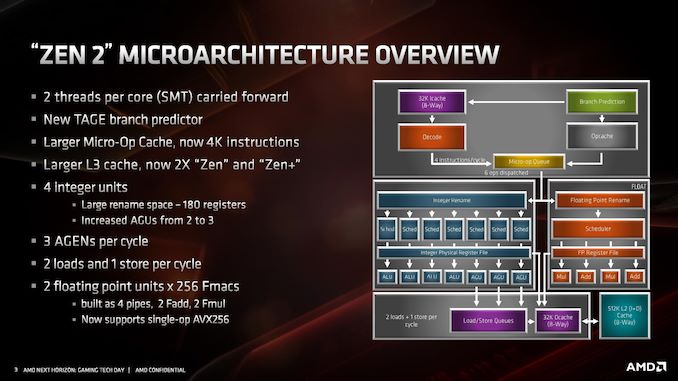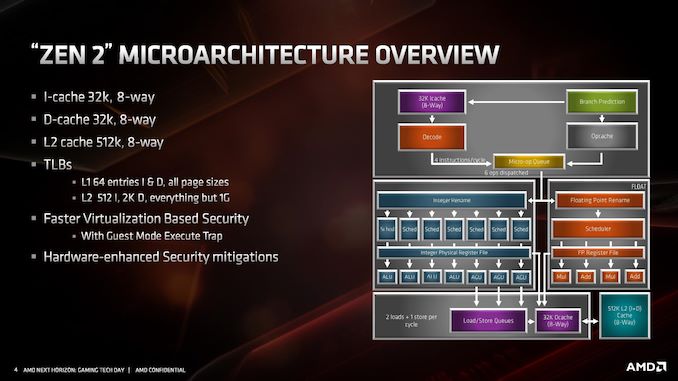AMD Zen 2 Microarchitecture Analysis: Ryzen 3000 and EPYC Rome
by Dr. Ian Cutress on June 10, 2019 7:22 PM EST- Posted in
- CPUs
- AMD
- Ryzen
- EPYC
- Infinity Fabric
- PCIe 4.0
- Zen 2
- Rome
- Ryzen 3000
- Ryzen 3rd Gen
AMD Zen 2 Microarchitecture Overview
The Quick Analysis
At AMD’s Tech Day, on hand was Fellow and Chief Architect Mike Clark to go through the changes. Mike is a great engineer to talk to, although what always amuses me (for any company, not just AMD) is that engineers that talk about the latest products coming to market are already working one, two, or three generations ahead at the company. Mike remarked that it took him a while to think back to the specific Zen+ to Zen 2 changes, while his mind internally is already several generations down the line.
An interesting element to Zen 2 is around the intention. Initially Zen 2 was merely going to be a die shrink of Zen+, going from 12nm down to 7nm, similar to what we used to see with Intel in its tick-tock model for the initial part of the century. However, based on internal analysis and the time frame for 7nm, it was decided that Zen 2 would be used as a platform for better performance, taking advantage of 7nm in multiple ways rather than just redesigning the same layout on a new process node. As a result of the adjustments, AMD is promoting a +15% IPC improvement for Zen 2 over Zen+.
When it comes down to the exact changes in the microarchitecture, what we’re fundamentally looking at is still a similar floorplan to what Zen looks like. Zen 2 is a family member of the Zen family, and not a complete redesign or different paradigm on how to process x86 – as will other architectures that have familial updates, Zen 2 affords a more efficient core and a wider core, allowing better instruction throughput.
At a high level, the core looks very much the same. Highlights of the Zen 2 design include a different L2 branch predictor known as a TAGE predictor, a doubling of the micro-op cache, a doubling of the L3 cache, an increase in integer resources, an increase in load/store resources, and support for single-operation AVX-256 (or AVX2). AMD has stated that there is no frequency penalty for AVX2, based on its energy aware frequency platform.
AMD has also made adjustments to the cache system, the most notable being for the L1 instruction cache, which has been halved to 32 kB, but associativity has doubled. This change was made for important reasons, which we’ll go into over the next pages. The L1 data cache and L2 caches are unchanged, however the translation lookaside buffers (TLBs) have increased support. AMD also states that it has added deeper virtualization support with respect to security, helping enable features further down the pipeline. As mentioned previously in this article, there are also security hardening updates.
For the quick analysis, it’s easy to tell that doubling the micro-op cache is going to offer a significant improvement to IPC in a number of scenarios, and combine that with an increase in load/store resources is going to help more instructions get pushed through. The double L3 cache is going to help in specific workloads, as would the AVX2 single-op support, but the improved branch predictor is also going to showcase raw performance uplift. All-in-all, for an on-paper analysis, AMD’s +15% IPC improvement seems like a very reasonable number to promote.
Over the next few pages, we’ll go deeper into how the microarchitecture has changed.












216 Comments
View All Comments
scineram - Wednesday, June 12, 2019 - link
No.Xyler94 - Thursday, June 13, 2019 - link
YesXyler94 - Thursday, June 13, 2019 - link
If he meant 2700x, of course. Darn misreading :Pnevcairiel - Monday, June 10, 2019 - link
A quick note. AVX2 is actually primarily Integer. AVX1 (or just AVX) is 256-bit floating point. The article often refers to "full AVX2 support", which isn't necessarily wrong, but Zen2 also adds full AVX support equally.NikosD - Saturday, June 15, 2019 - link
AVX256 is both integer and floating point because it includes AVX2 FMA which doubles floating point capability compared to AVX1NikosD - Saturday, June 15, 2019 - link
AVX256 was a typo, I meant AVX2 obviously.eastcoast_pete - Monday, June 10, 2019 - link
Thanks Ian? Two questions: what is the official memory bandwidth for the consumer chips? (Sounds like they remain dual channel) and: Any words on relative performance of AMD's AVX 2 implementation vs. Intel's AVX 512 with software that can use either?emn13 - Tuesday, June 11, 2019 - link
AVX-512 is a really misleading name; the interesting... bits... aren't the 512-bit width, but the dramatically increased flexibility. All kinds of operations are now maskable and better reshufflable, and where specific sub-segements of the vector were used, they're now sometimes usable at 1bit granularity (whereas previously that was greater).Assuming x86 sticks around for high-perf computing long enough for compilers to be able to automatically leverage it and then for most software to use it, AVX-512 is likely to be quite the game changer - but given intel's super-slow rollout so far, and AFAIK no AMD support... that's going to take a while.
Which is all a long-winded way to say that you might well expect AMDs AVX2 implementation to be not all that much slower than intel's 512 when executing code that's essentially AVX2-esque (because intel drops the frequency, so won't get the full factor 2 speedup), but AVX-512 has the potential to be *much* faster than that, because the win isn't actually in vector-width.
GreenReaper - Tuesday, June 11, 2019 - link
Intel's own product segmentation has caused it to lose its first-mover advantage here. System software aside, there's little point in most developers seeking to use instructions that most of their users will not have (and which they themselves may not have). By the time software does support it, AMD is likely to have it. And of course an increasing number of developers will be pouncing on Zen 2 thanks to fast, cheap cores that they can use to compile on...HStewart - Tuesday, June 11, 2019 - link
Intel only had AVX 512 versions in Xeon and Xeon derive chips, but the with Ice Lake ( don't really count Canon Lake test run ) AVX 512 will hit main stream starting with in a month and 2020 should be fully roll out.As for AMD AVX 2 is true 256 bit, the last I heard is that it actually like dual 128 bit unless they change it in Zen 2. I serious doubt AMD AVX 2 implement is going to any much different that Intel AVX 2 and AVX 512 is a total different beast.
It funny years ago we heard the same thing about 64 bit in x86 instructions, and now we here in 512 bit AVX.
As for as AMD support for AVX 512, that does not matter much since Intel is coming out with AVX 512 in full line over next year or so.
But keep in mind unlike normal x86 instruction, AVX is kind of specialize with vectorize processing, I know with Video processing like Power Director this was a deciding factor earlier for it.,